Number 1 Chinese Food
Table of Contents
- 1. Rice Noodle - Number 1 Chinese Food for Breakfast
- 2. Peking Roast Duck – No. 1 Chinese Food in Beijing
- 3. Jiaozi – No. 1 Chinese Food in Spring Festival
- 4. Zongzi – No. 1 Chinese Food in Duanwu Festival
- 5. Moon Cake – No. 1 Chinese Food in Mid-Autumn Festival
- 6. Hot Pot – No. 1 Chinese Food in Winter
- 7. Tofu – No. 1 Chinese Food for Vegetarians
How delicious food is important in China? Chinese saying “Food is What Matters Most to the People” shows that food is one of the most important things in daily life. Chinese people make every effort to make use of what they can get locally to improve their cooking techniques in all its history. Thus geographic features including mountains, rivers, forests, and deserts have a strong effect on the local available ingredients, considering that the climate of China varies from tropical in the south to subarctic in the northeast.
“Fashion is in Europe, living is in America, but eating is in China” is another phrase shows the popularity of Chinese food around the world. There are so many but different foods in China, to try the most representative ones is the easy way to satisfy your taste buds. Here are some No. 1 Chinese foods in different categories.
Rice Noodle - Number 1 Chinese Food for Breakfast
Breakfast is not as important as dinner for Chinese people, but that doesn’t mean it counts for little. Rice is one of the staple foods largely grown in China and it is consumed in many different forms besides cooking rice grains with water directly. Authentic Chinese food, rice noodle is made from rice flour, called Mifen in Chinese. As rice noodle is cooked food material, you just need to rinse it in the boiling water and then add soup, sauce, meat and vegetable to get a bowl of rice noodle. The convenience makes it popular all over China, while the sauce becomes the soul of the noodles, which usually reflects characters of local people.Rice noodle in different places:
Kunming – Cross Bridge Rice Noodle (过桥米线)Guilin – Guilin Mifen (桂林米粉)
Liuzhou – Liuzhou Snail Rice Noodle (柳州螺蛳粉)
Guangzhou – Flat Rice Noodle (广东沙河粉)
Nanchang – Stirred Rice Noodle (南昌拌粉)
Changde – Beef Rice Noodle (常德牛肉粉)
Chongqing – Hot and Sour Rice Noodle (重庆酸辣粉)
Xinjiang – Stir-fried Rice Noodle (新疆炒粉)
Guizhou - Mutton rice noodles (贵州羊肉粉)
Hainan – Baoluo Rice Noodle (海南抱罗粉)
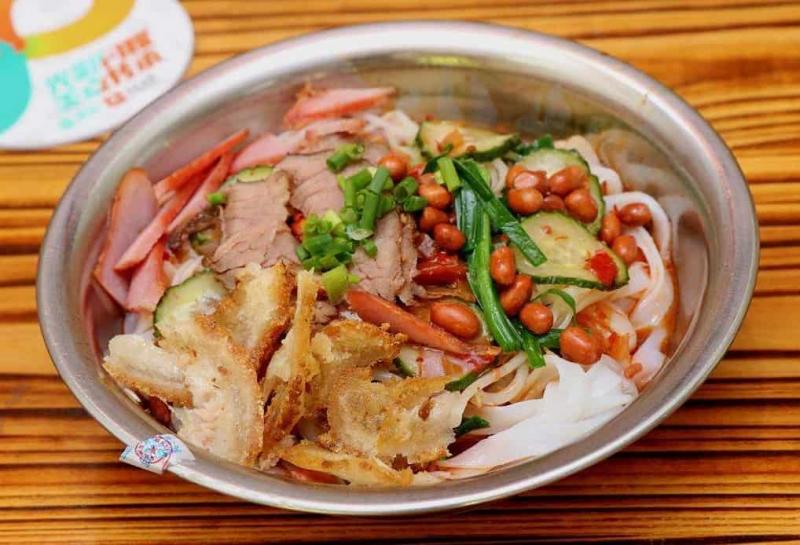
Peking Roast Duck – No. 1 Chinese Food in Beijing
Peking Roast Duck is no doubt the most famous Chinese cuisine for travellers to Beijing. Originated in Nanjing in early Ming Dynasty, Nanjing Roast Duck was taken to Beijing when Yongle Emperor moved capital from Nanjing to Beijing. The most famous Quanjude Restaurant opened in 1864 and started the glory of Peking Roast Duck.
Peking roast duck is known for its thin, crispy skin. You will be usually served mostly the skin and little meat of the duck, sliced by the cook in front of you. The most popular way to eat is wrapping the meat with spring onion, cucumber and sweat bean sauce with a steamed pancake. Remainder of the roast duck, the carved duck, is served in a broth with ingredients such as Chinese cabbage and soft tofu, or be chopped and stir-fried in sweet bean sauce.
Mainly there are two styles of Roast Duck: closed-over style and open-oven style. In closed-oven style, duck meat is combined well with the fat under the skin, and therefore is juicy and tender. While in open-oven style, the fat is usually melted during the cooking process, so the skin is crispy. Quanjude is the representative of open-oven style and Bianyifang is in closed-oven style.
Extensive reading: Find the Best Peking Roasted Duck Restaurants in Beijing
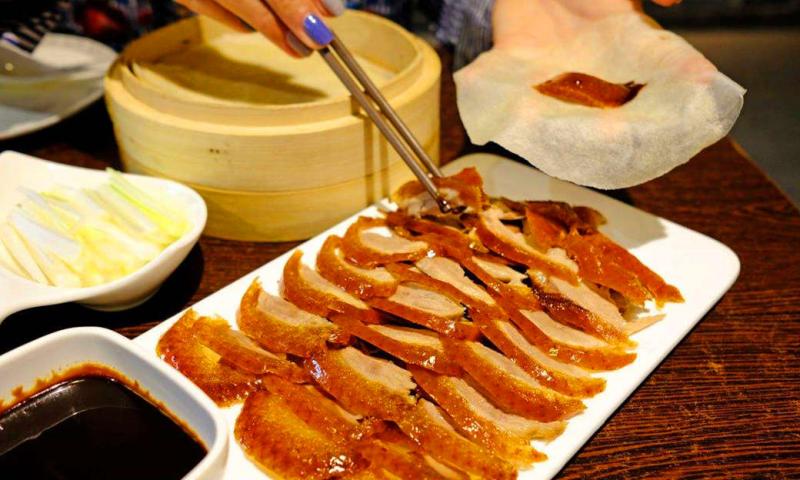
Jiaozi – No. 1 Chinese Food in Spring Festival
“Nothing tastes better than Jiaozi”, this Chinese saying shows the importance of Jiaozi in Chinese cuisine. In Chinese Spring Festival, Jiaozi is a must on the table in north China. Traditionally, Jiaozi making should be finished before 12pm on the Lunar New Year’s Eve. It’s a great time for all family members to work on the same thing and communicate to strengthen family ties. Dumpling with meat stuffing is usually taken on the New Year’s Eve, while on the first day of the New Year, plain stuffing is usually enjoyed with family members.
Pork, mutton, beef, leek, green Chinese onion, radish and Chinese cabbage are most popular materials used for stuffing. While in Lunar New Year, people would put date, peanut, chestnut or coin in the stuffing. Person who eats one with bonus is a lucky fellow. Date means sweet life, peanut means health and longevity and coin means good fortune in the coming new year.
Chinese people may have a hundred ways to wrap dumplings, but most popular look is crescent-shaped. In Spring Festival, a Jiaozi in the shape of a sycee or Yuanbao (shoe-shaped gold or silver ingot used in imperial China) is most welcomed by people as it means good fortune in China.
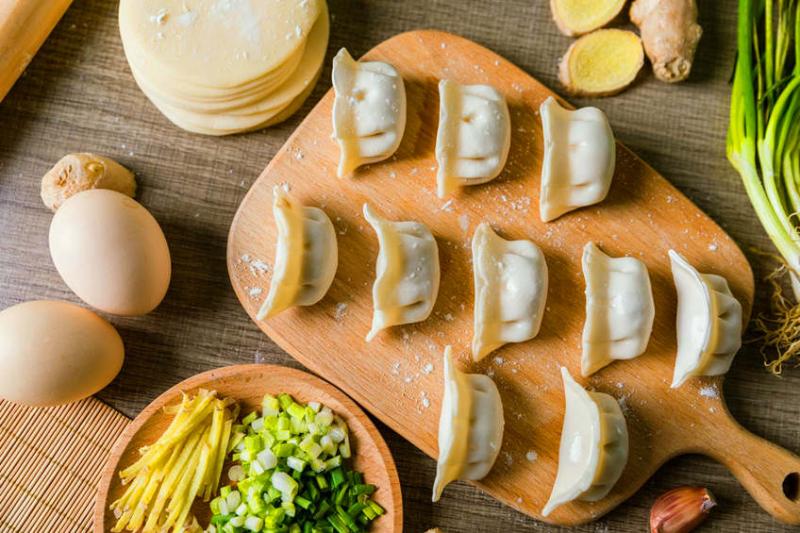
Zongzi – No. 1 Chinese Food in Duanwu Festival
Zongzi is another famous Chinese dumpling besides Jiaozi and Baozi. As a traditional Chinese food, it is usually eaten in a special Chinese festival – Duanwu Festival only. Though now it is so popular that you can find it anytime and anywhere in China, Zongzi is still the No. 1 food in Duanwu Festival.
More than a delicious food, Zongzi carries rich cultural connotation in China. In order to commemorate the death of Qu Yuan, a famous patriotic poet from the kingdom of Chu in Warring States period, Chinese people cast rice dumplings into the Miluo River on the day when Qu Yuan was thrown into the river every year, hoping that the fish in the river would eat the rice dumplings without harming Qu Yuan's body. By the 6th century, the date to offer zongzi was set on the 5th day of the 5th month of the lunar calendar (Duanwu Festival or Drgon Boat Festival).
Like all other Chinese foods, Zongzi cannot be in a single shape and with same recipe, though sticky rice would always keep its unshakable position (this is the reason that it is also called Sticky rice dumpling). Besides pork and mung beans, chicken, ham, yolk of salted eggs, lotus seed, red beans and all kinds of nuts are used to make filling, different from region to region. Generally people in north China like sweet fillings while people in south China enjoy salty Zongzi more. Most Zongzi are in a shape of a pillow or an ox cone. While in some regions of China, people prefer other shapes, like pagoda-shaped Zongzi in Cantonese area. In Nanning, capital of Guangxi Zhuang Autonomous Region, you can find the largest Zongzi in China. It is usually around 1 kg each and called “pillow Zong” locally with the middle part higher than two ends.
Extensive reading: About Zongzi - Chinese Rice Dumpling
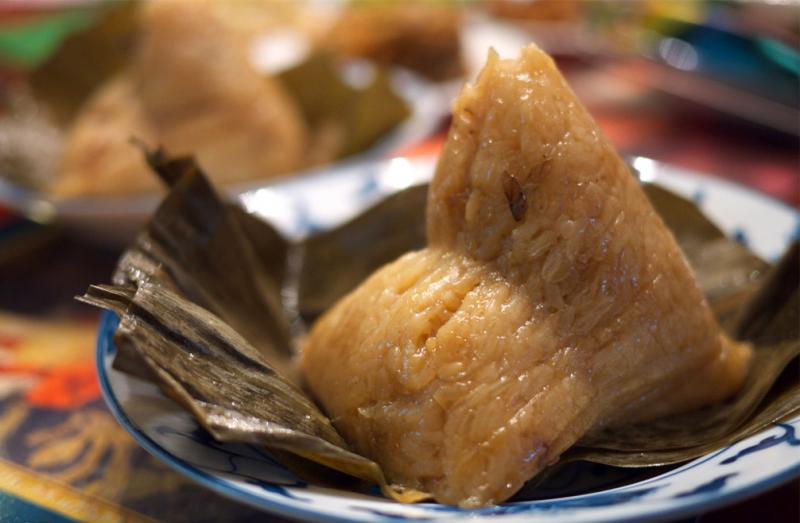
Moon Cake – No. 1 Chinese Food in Mid-Autumn Festival
It seems dumplings are Chinese people’s special preference in festival – Jiaozi in Spring Festival, Zongzi in Duanwu Festival, Tangyuan in Yuanxiao Festival. Well, in mid-autumn festival, it is moon cake. Dumplings are all in plain appearance but with rich fillings inside, similar to character of Chinese people.
Moon cakes typically have a thin pastry crust encasing a sweet, dense filling, and may contain one or more salted yolks inside their centers that symbolize the full moon. Most popular fillings used to make traditional moon cakes are lotus seed paste, sweet bean paste, jujube paste, mixed nuts including walnuts, pumpkin seeds, watermelon seeds, peanuts, sesame seeds, candied winter melon and ham. Moon cakes are usually eaten in small wedges, accompanied by tea.
There are many regional variants of the moon cake and main types are:
Beijing-style Moon Cake: originated in Beijing and Tianjin and is the typical variation in North China. It features the delicate use of sweetness, moderate allotment of skin and fillings, and meticulous decoration. The most famous filling flavors are rock sugar, sweet Osmanthus, nuts, hawthorn and wisteria.
Cantonese-style Moon Cake: originated in south China with abundant of food materials, the ingredients used for the fillings are much more various: lotus seed paste, melon seed paste, nuts, ham, chicken, duck, roast pork, mushrooms, egg yolks, etc. They’re more delicate with less oil and sugar be used.
Shanghai-style Moon Cake: is made from shortcrust pastry which is rich, crumbly and buttery crust like pie dough. The most popular fillings are similar to those sweet Cantonese-style moon cake such as sweetened red bean paste, lotus seed paste and taro paste with egg yolks in the middle of the filling.
Hong Kong-style Moon Cake: Hong Kong has gained its own style of moon cake mainly from the snow skin moon cake, which breaks the tradition of making crust with dough only.
Ningbo-style Moon Cake: The fillings are either seaweed or ham; it is also known for its spicy and salty flavor.
Suzhou-style Moon Cake: with a history of a thousand years, this style is known for its layers of flaky dough and generous allotment of sugar and lard. Filling made from salt and pepper is common in flaky Suzhou-style moon cakes.
Yunnan-style Moon Cake: Instead of using wheat flour only, Yunnan people add rice flour and buckwheat flour to make the dough. Fillings with famous Xuanwei ham and vary flower petals are two wow factors of Yunnan style moon cake.
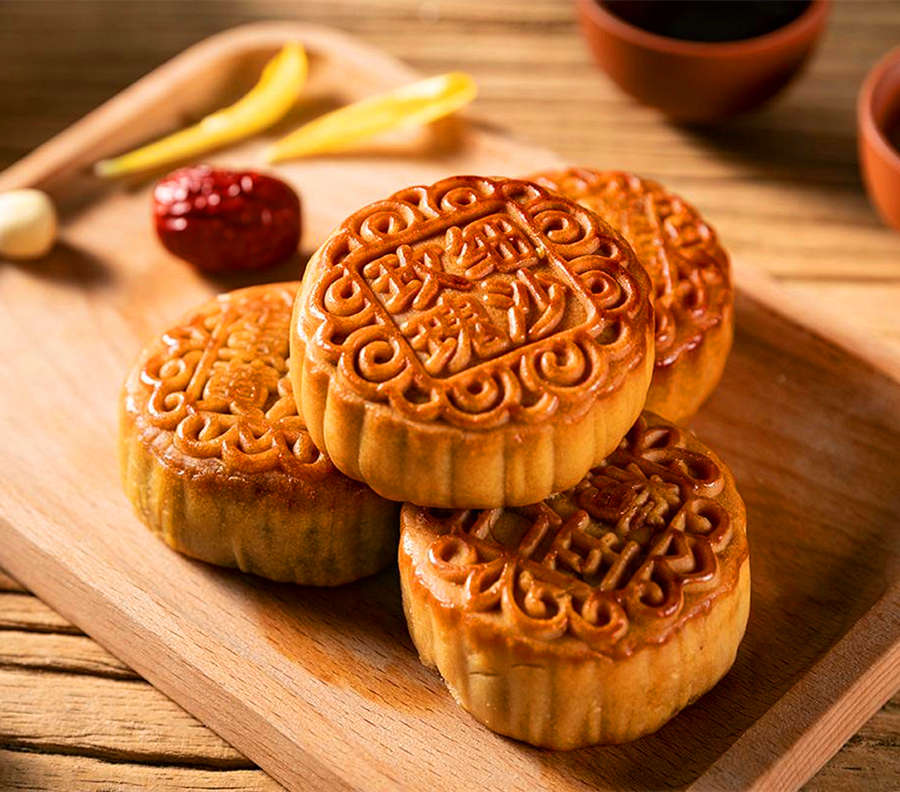
Hot Pot – No. 1 Chinese Food in Winter
Xian (鲜), which in English is similar to “fresh” or “unami” but more than that, is the most important and also the most difficult criterion to judge a Chinese food. Unlike western people enjoy cold or freezing food, Chinese people prefer “hot” food, which means fresh out of the pot, especially in cold winter. So, when these two combine together, hot pot must be the No. 1 choice in winter.
Most hot pots are served with flavorful broth in a large metal pot. Raw ingredients, such as meat and vegetables, are placed into the simmering broth. Typical hot pot ingredients include thinly sliced meat, leaf vegetables, mushrooms, egg dumplings, tofu and seafood. Raw ingredients are pre-sliced into thin sections in order to cook quickly. In south China, “dry” hot pot is another style. The most famous is mala xiangguo (麻辣香锅) , which are similar to mala hot pot in ingredients and seasoning, but stir-fry them instead of cooking in broth.
Highly recommended Chinese hot pot for people travel in China:
Instant-boiled mutton (涮羊肉) in Beijing – it is the representative of northern style hot pot. Most food historians agree that the hotpot was first brought to Beijing by the Mongolians during the Yuan Dynasty. With further refining by Muslim chefs and local chefs, it has become a Beijing icon, especially its tall copper pots. Eaters pick up some pre-sliced raw lamb using chopsticks, put it in the boiling hot-pot, and remove it as soon as the lamb changes color. Sauce for the cooked lamb is normally a mixture of sesame sauce, chili oil, leeks, and more.
Sichuan hot pot in Chongqing or Chengdu – For people like spicy food, this is the one you can not miss. As one of the cities of Sichuan Province before 1997, Chongqing is mainly similar to Chengdu in food. Both are flavored with chilli peppers and Sichuan pepper for a spicy and numbing flavor. But Chongqing hot pot uses more oil in broth and more meats
Wild mushroom hot pot in Yunnan –Due to the vast forests and mild climatic conditions, Yunnan is a main origin of edible mushrooms. Mushroom hot pot is traditionally prepared with chicken broth, slow-cooked with the simplest spices (i.e., ginger and Sichuan pepper) for a couple of hours. Sometimes, a piece of Xuanwei ham is added to further enrich the flavor. The star ingredients for mushroom hot pot are no doubt wild mushrooms foraged from the mountains.
Congee hot pot in Shunde – As one of the five Chinese cities in UNESCO’s “City of Gastronomy” list, Shunde has many delicious foods, and congee hot pot is one of them. Unlike all other brothes, clear soup or mala broth, Shunde people make their favorite congee into broth for hot pot. The congee base used in the hotpot is called wumizhou (毋米粥), which means that there’s “no concrete rice” in it. The right way to cook is putting seafood first and then fish and other meats, vegetables at the end.
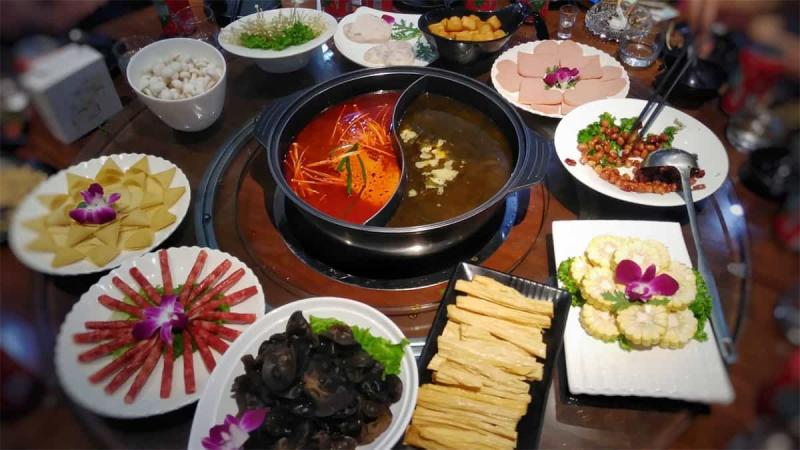
Tofu – No. 1 Chinese Food for Vegetarians
Tofu originated in China and has been part of Chinese cuisine for over 2,000 years, since the Han dynasty. Due to its low calorie, rich protein and high nutritional composition in iron, calcium, Tofu is widely used in Chinese cuisine. It is the best alternative of meat, thus becoming the number one food for vegetarians. People who take a meat-free trip in China will always find tofu on the table, but all in different look and flavor.
Tofu can be generally divided into two categories, fresh tofu and pressed tofu, with the difference in pressing procedure. Fresh tofu is produced directly from soy milk and has a smooth and gel-like texture and is commonly known as soft tofu, tofu pudding, or douhua (豆花). People add sugar, honey, soy sauce, pickles, chilli oil, scallions and whatever they like to get their favorite flavor.
Pressed tofu is mainly used to cook various cuisines in China. According to the time the fresh tofu is pressed, people can get different pressed tofu from soft to hard. The famous Mapo Tofu (麻婆豆腐) uses soft tofu, while Fried Dougan (炒豆干) needs deeply pressed tofu. Pressed tofu can also be processed into different flavor by frying, stewing and fermenting, and then being used to cook with meat or vegetables, make dumplings, or became a flavoring condiment.
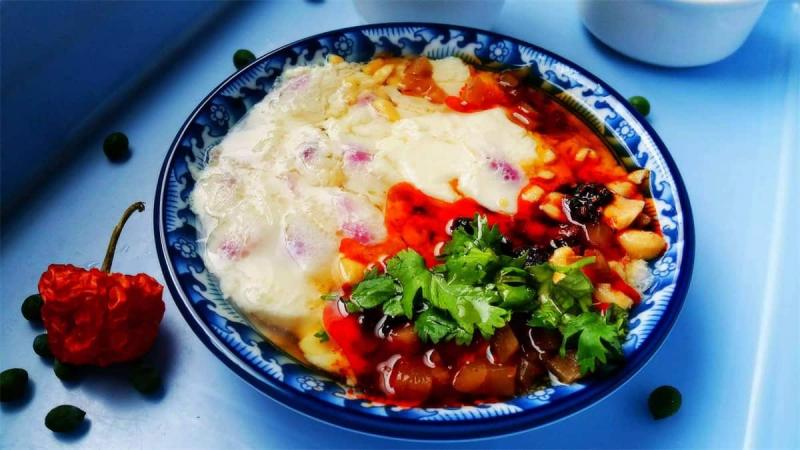
Recommended China Food Tours: